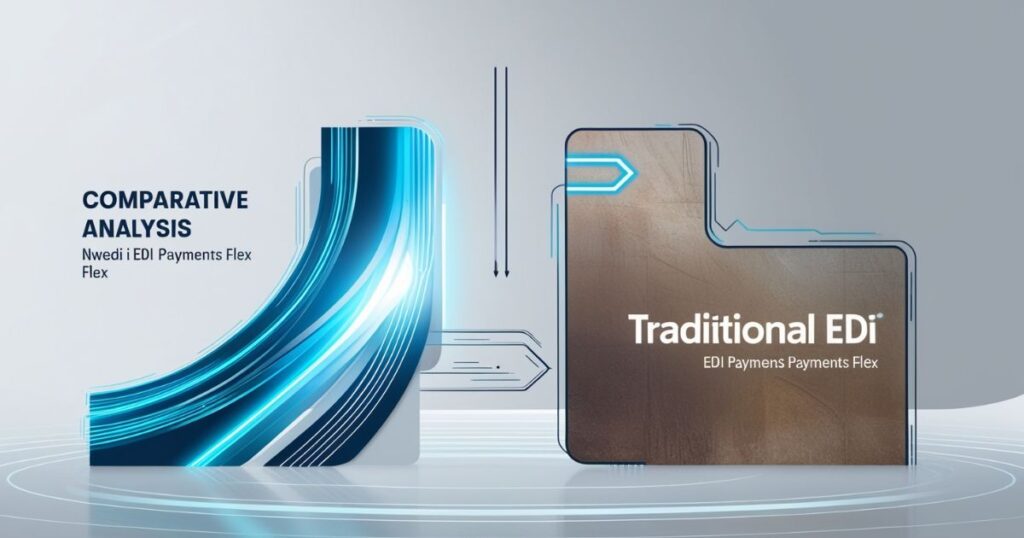In the dynamic landscape of modern business, Electronic Data Interchange (EDI) has emerged as a transformative technology revolutionizing financial transactions. The National Workgroup for EDI (NWEDI) has pioneered EDI Payments Flex, a cutting-edge system that redefines how organizations exchange critical financial information.
By replacing traditional paper-based processes with sophisticated digital solutions, this innovative platform offers unprecedented efficiency, security, and flexibility. EDI Payments Flex represents more than just a technological upgrade—it’s a strategic approach to streamlining business operations, enabling companies to navigate the complex global economic environment with unprecedented agility and precision.
Demystifying EDI Payments: The Backbone of Modern Business Transactions
In the rapidly evolving landscape of digital business operations, Electronic Data Interchange (EDI) has emerged as a transformative technology revolutionizing how companies conduct financial transactions.
Electronic Data Interchange represents a sophisticated electronic method of exchanging critical business documents such as invoices, purchase orders, and payment records between organizations, effectively replacing traditional paper-based communication systems.
The EDI Payments Flex system, championed by the National Workgroup for EDI (NWEDI), represents a quantum leap in digital transaction management. This innovative approach has fundamentally reshaped how businesses handle financial interactions, introducing unprecedented levels of efficiency, security, and flexibility in electronic transactions.
NWEDI and EDI Payments Flex
The National Workgroup for EDI (NWEDI) stands at the forefront of electronic transaction technology, dedicating extensive research and development to advancing digital transaction methodologies. Their flagship concept, EDI Payments Flex, focuses on creating more fluid and intelligent financial transaction processes that transcend traditional payment mechanisms.
EDI Payments Flex is not merely a technological solution but a comprehensive approach to reimagining business financial interactions. By integrating advanced automation, real-time processing, and robust security protocols, this system represents a significant evolution in electronic payment strategies.
Raiser 6795 EDI Payments: Smart Choice for Modern Effective Businesses

Modern businesses require sophisticated tools that can adapt to complex and dynamic financial environments. The EDI Payments Flex system meets these demanding requirements by offering unprecedented flexibility and efficiency in transaction management. Its intelligent design allows organizations to streamline their financial operations, reduce manual interventions, and minimize potential errors.
A Major Player in the EDI Arena
The National Workgroup for EDI has cultivated a rich history of technological innovation in electronic data exchange. Comprised of intellectual enthusiasts and technological experts, NWEDI has been instrumental in defining and refining electronic data interchange systems across various industry sectors.
Mission and Influence of Nwedi EDI Payments Flex
The primary objective of EDI Payments Flex is to continuously enhance electronic transaction capabilities. By focusing on improving inter-business financial interfaces, NWEDI has facilitated remarkable advancements in transaction speed, security, and accuracy.
Understanding EDI Payments
Electronic Data Interchange (EDI) payments represent a sophisticated digital mechanism for transferring funds between businesses. This process involves the comprehensive digital transfer of payment documents, including intricate transaction records and invoices, effectively eliminating traditional paper-based transaction methods.
How EDI Payments Work
EDI payments operate through standardized electronic document formatting protocols. When a business initiates a payment, a comprehensive digital document is transmitted to the supplier, containing all requisite transaction details such as amount, date, and relevant financial information.
Benefits of EDI Payments
Efficiency Redefined
The EDI Payments Flex system dramatically streamlines transaction processes by eliminating manual paper handling and data input. This approach significantly reduces processing time and minimizes the potential for human error.
Unparalleled Accuracy
By leveraging uniform formatting standards and automated procedures, EDI payments achieve exceptional precision. The electronic system’s inherent design effectively eliminates traditional human error sources, guaranteeing accurate payment processing.
Speed of Transactions
EDI payments represent a quantum leap in transaction velocity. The near-instantaneous processing capabilities dramatically improve cash flow management and reduce overall transaction completion times.
Also Read: What is CCB MADISON charge on your bank statement
Discovering Nwedi EDI Payments Flex
What is Nwedi EDI Payments Flex?
EDI Payments Flex serves as an advanced alternative to conventional Electronic Data Interchange payment systems. This innovative platform transcends basic fund transfers by integrating multiple payment methods and data transaction processes into a seamless, intelligent ecosystem.
Key Features
Advanced Integration: Distinguishing itself through sophisticated interconnectivity, EDI Payments Flex can process complex transactions across diverse accounting software platforms.
Enhanced Security: Utilizing cutting-edge encryption protocols, the system ensures comprehensive protection of sensitive financial information during digital transactions.
Greater Customization: Businesses can tailor the system to their specific operational requirements, from data formatting preferences to automated processing rules.
Real-Time Processing: Enabling instantaneous transaction management with current, accurate financial statistics.
Comparative Analysis: Nwedi EDI Payments Flex vs Traditional EDI

Flexibility and Customization
Traditional EDI systems often employ rigid, standardized approaches. In contrast, EDI Payments Flex offers unprecedented customization, allowing businesses to adapt the system precisely to their unique operational needs.
Enhanced Connectivity
While conventional EDI systems manage basic transactions, EDI Payments Flex provides extensive connectivity options, interfacing seamlessly with multiple systems and software platforms.
Speed and Efficiency
EDI Payments Flex represents a significant advancement in transaction speed and efficiency, outperforming traditional systems through real-time processing and advanced automation capabilities.
Implementation of Nwedi EDI Payments Flex
The journey of integrating EDI Payments Flex into an organizational ecosystem requires strategic planning and comprehensive understanding. Businesses must first conduct a thorough assessment of their existing payment infrastructure to determine compatibility and potential areas of enhancement.
The implementation process involves collaborative engagement with specialized EDI providers or internal information technology teams. These experts will help configure the system to align precisely with specific business requirements, ensuring seamless integration and minimal operational disruption.
Critical considerations during implementation include comprehensive employee training programs, system compatibility evaluations, and meticulous testing protocols. Organizations must invest significant time in preparing their workforce to navigate the new technological landscape, providing robust support mechanisms and educational resources.
Challenges and Strategic Considerations
Implementing EDI Payments Flex is not without challenges. Companies must carefully evaluate their current technological infrastructure, potentially requiring substantial software and hardware upgrades. The initial implementation costs can be substantial, though the long-term financial benefits typically outweigh the initial investment.
The learning curve associated with adopting new technological systems demands patience and strategic planning. Management must cultivate a culture of technological adaptability, encouraging employees to embrace innovation and view technological transformation as an opportunity for professional growth.
The Changing World of EDI Payments
Emerging Trends in Digital Transactions
The landscape of electronic transactions continues to evolve rapidly. Automation stands at the forefront of this transformation, promising reduced manual interventions and more fluid transactional processes.
Artificial Intelligence and machine learning are increasingly being integrated into payment systems, enabling sophisticated fraud detection and predictive financial analysis.
Mobile compatibility represents another significant trend, reflecting the growing mobile-centric business environment. EDI Payments Flex is progressively optimizing its platforms to support seamless transactions across various digital devices, ensuring businesses can manage financial operations from anywhere in the world.
Impact of NWEDI on Electronic Transactions
The National Workgroup for EDI plays a pivotal role in establishing standardized protocols for electronic transactions. Their ongoing work ensures consistency, security, and reliability across diverse industry sectors, contributing to the broader digital transformation of financial systems.
Flex Future of EDI Payments
Looking forward, EDI Payments Flex is poised for remarkable technological evolution. The system is expected to become increasingly sophisticated, offering more personalized solutions tailored to specific business requirements.
Blockchain technology presents an exciting frontier, promising additional layers of security and transparency in digital transactions. International payment processing could become more streamlined, with enhanced capabilities for managing complex multi-currency transactions.
A Bright Future for Technological Innovation
The trajectory of EDI payments points toward greater autonomy, enhanced security, and improved user experiences. Organizations like NWEDI will continue to play a crucial role in carefully implementing these technological advancements, ensuring smooth and secure transitions.
Benefits of EDI Payments Flex: Adopting New Technology

Key Advantages Revisited
EDI Payments Flex offers unparalleled mobility and adaptability, capable of managing diverse transaction types across various business environments. Its robust security infrastructure, powered by advanced encryption protocols, ensures comprehensive protection of sensitive financial data.
The system’s automation capabilities significantly reduce operational time and cost, making it an attractive solution for businesses of all sizes seeking to modernize their financial processes.
Technological Development in Modern Business
In today’s rapidly changing technological landscape, embracing innovative systems is not merely a trend but a strategic imperative. EDI Payments Flex exemplifies how technological transformation can drive efficiency, security, and adaptability in business operations.
Final Reflections: The Path Forward
EDI Payments Flex represents more than a technological upgrade; it symbolizes a fundamental shift in how modern businesses conceptualize and execute financial transactions. Its comprehensive advantages and promising future make it an indispensable tool for organizations committed to digital excellence.
For businesses prepared to embrace technological innovation, EDI Payments Flex offers a powerful platform for automating transactions and positioning themselves at the forefront of digital financial management.
Conclusion
The journey of digital financial transformation continues to unfold, with EDI Payments Flex serving as a beacon of innovation. As businesses navigate increasingly complex global economic landscapes, technologies like these will prove crucial in maintaining competitiveness, efficiency, and strategic agility.
FAQ’s
What are Nwedi EDI payments?
Nwedi EDI payments are electronic financial transactions managed by the National Workgroup for EDI to streamline business payment processes.
What is an EDI payment?
An EDI payment is a digital method of transferring funds between businesses using standardized electronic document formats.
Why did I receive an EDI payment on my bank statement?
You likely received an EDI payment as part of a business transaction where the payer used electronic data interchange for financial settlement.
Who sends EDI payments?
EDI payments are typically sent by businesses, corporations, and organizations using electronic data interchange systems to process financial transactions efficiently.
Explore the latest news and insights from Echozynth and beyond at Echozynth.com

Kiara Arushi is the dedicated admin of this personal website, which serves as a comprehensive hub for general information across various topics. With a keen eye for detail and a passion for knowledge sharing, Kiara curates content that is both informative and engaging, catering to a diverse audience.
Her commitment to providing accurate and up-to-date information ensures that visitors find valuable insights and practical tips in every post. Whether you’re seeking the latest trends or timeless advice, Kiara’s expertise makes this site a trusted resource for all.


